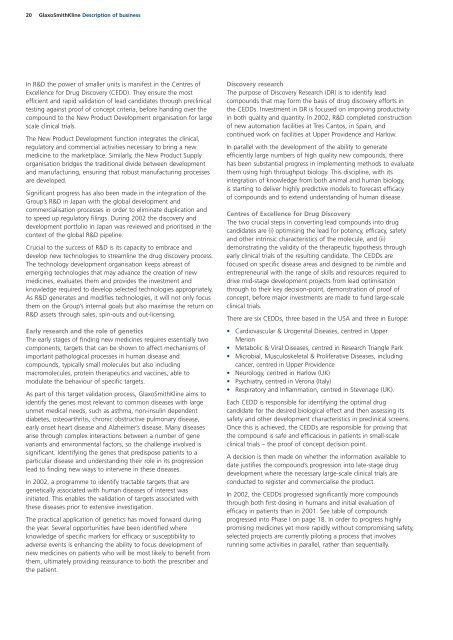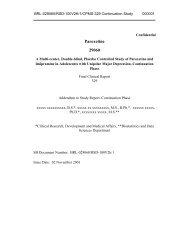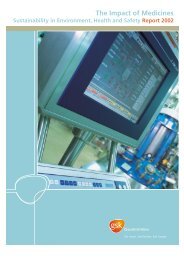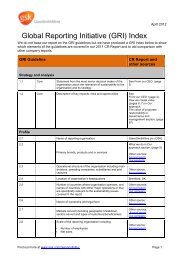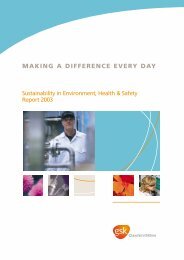GSK Annual Report 2002
GSK Annual Report 2002
GSK Annual Report 2002
Create successful ePaper yourself
Turn your PDF publications into a flip-book with our unique Google optimized e-Paper software.
20 GlaxoSmithKline Description of business<br />
In R&D the power of smaller units is manifest in the Centres of<br />
Excellence for Drug Discovery (CEDD). They ensure the most<br />
efficient and rapid validation of lead candidates through preclinical<br />
testing against proof of concept criteria, before handing over the<br />
compound to the New Product Development organisation for large<br />
scale clinical trials.<br />
The New Product Development function integrates the clinical,<br />
regulatory and commercial activities necessary to bring a new<br />
medicine to the marketplace. Similarly, the New Product Supply<br />
organisation bridges the traditional divide between development<br />
and manufacturing, ensuring that robust manufacturing processes<br />
are developed.<br />
Significant progress has also been made in the integration of the<br />
Group’s R&D in Japan with the global development and<br />
commercialisation processes in order to eliminate duplication and<br />
to speed up regulatory filings. During <strong>2002</strong> the discovery and<br />
development portfolio in Japan was reviewed and prioritised in the<br />
context of the global R&D pipeline.<br />
Crucial to the success of R&D is its capacity to embrace and<br />
develop new technologies to streamline the drug discovery process.<br />
The technology development organisation keeps abreast of<br />
emerging technologies that may advance the creation of new<br />
medicines, evaluates them and provides the investment and<br />
knowledge required to develop selected technologies appropriately.<br />
As R&D generates and modifies technologies, it will not only focus<br />
them on the Group’s internal goals but also maximise the return on<br />
R&D assets through sales, spin-outs and out-licensing.<br />
Early research and the role of genetics<br />
The early stages of finding new medicines requires essentially two<br />
components; targets that can be shown to affect mechanisms of<br />
important pathological processes in human disease and<br />
compounds, typically small molecules but also including<br />
macromolecules, protein therapeutics and vaccines, able to<br />
modulate the behaviour of specific targets.<br />
As part of this target validation process, GlaxoSmithKline aims to<br />
identify the genes most relevant to common diseases with large<br />
unmet medical needs, such as asthma, non-insulin dependent<br />
diabetes, osteoarthritis, chronic obstructive pulmonary disease,<br />
early onset heart disease and Alzheimer’s disease. Many diseases<br />
arise through complex interactions between a number of gene<br />
variants and environmental factors, so the challenge involved is<br />
significant. Identifying the genes that predispose patients to a<br />
particular disease and understanding their role in its progression<br />
lead to finding new ways to intervene in these diseases.<br />
In <strong>2002</strong>, a programme to identify tractable targets that are<br />
genetically associated with human diseases of interest was<br />
initiated. This enables the validation of targets associated with<br />
these diseases prior to extensive investigation.<br />
The practical application of genetics has moved forward during<br />
the year. Several opportunities have been identified where<br />
knowledge of specific markers for efficacy or susceptibility to<br />
adverse events is enhancing the ability to focus development of<br />
new medicines on patients who will be most likely to benefit from<br />
them, ultimately providing reassurance to both the prescriber and<br />
the patient.<br />
Discovery research<br />
The purpose of Discovery Research (DR) is to identify lead<br />
compounds that may form the basis of drug discovery efforts in<br />
the CEDDs. Investment in DR is focused on improving productivity<br />
in both quality and quantity. In <strong>2002</strong>, R&D completed construction<br />
of new automation facilities at Tres Cantos, in Spain, and<br />
continued work on facilities at Upper Providence and Harlow.<br />
In parallel with the development of the ability to generate<br />
efficiently large numbers of high quality new compounds, there<br />
has been substantial progress in implementing methods to evaluate<br />
them using high throughput biology. This discipline, with its<br />
integration of knowledge from both animal and human biology,<br />
is starting to deliver highly predictive models to forecast efficacy<br />
of compounds and to extend understanding of human disease.<br />
Centres of Excellence for Drug Discovery<br />
The two crucial steps in converting lead compounds into drug<br />
candidates are (i) optimising the lead for potency, efficacy, safety<br />
and other intrinsic characteristics of the molecule, and (ii)<br />
demonstrating the validity of the therapeutic hypothesis through<br />
early clinical trials of the resulting candidate. The CEDDs are<br />
focused on specific disease areas and designed to be nimble and<br />
entrepreneurial with the range of skills and resources required to<br />
drive mid-stage development projects from lead optimisation<br />
through to their key decision-point, demonstration of proof of<br />
concept, before major investments are made to fund large-scale<br />
clinical trials.<br />
There are six CEDDs, three based in the USA and three in Europe:<br />
• Cardiovascular & Urogenital Diseases, centred in Upper<br />
Merion<br />
• Metabolic & Viral Diseases, centred in Research Triangle Park<br />
• Microbial, Musculoskeletal & Proliferative Diseases, including<br />
cancer, centred in Upper Providence<br />
• Neurology, centred in Harlow (UK)<br />
• Psychiatry, centred in Verona (Italy)<br />
• Respiratory and Inflammation, centred in Stevenage (UK).<br />
Each CEDD is responsible for identifying the optimal drug<br />
candidate for the desired biological effect and then assessing its<br />
safety and other development characteristics in preclinical screens.<br />
Once this is achieved, the CEDDs are responsible for proving that<br />
the compound is safe and efficacious in patients in small-scale<br />
clinical trials – the proof of concept decision point.<br />
A decision is then made on whether the information available to<br />
date justifies the compound’s progression into late-stage drug<br />
development where the necessary large-scale clinical trials are<br />
conducted to register and commercialise the product.<br />
In <strong>2002</strong>, the CEDDs progressed significantly more compounds<br />
through both first dosing in humans and initial evaluation of<br />
efficacy in patients than in 2001. See table of compounds<br />
progressed into Phase I on page 18. In order to progress highly<br />
promising medicines yet more rapidly without compromising safety,<br />
selected projects are currently piloting a process that involves<br />
running some activities in parallel, rather than sequentially.


